Introduction to Ornithology
Ancient and Modern Birds
Paleontologists trace the origins of birds to about 121 million years ago in the early Cretaceous period. Birds are actually the last surviving dinosaurs, being descendants of the primitive avialans (whose members include Archaeopteryx) which first appeared about 160 million years ago in China. Birds are considered feathered theropod dinosaurs. The phylogeny is as follows:
Kingdom: Animalia
Phylum: Chordata
Class: Reptila
Clade: Archosauria
Clade: Dinosauria
Clade: Avemetatarsalia
Clade: Ornithurae
Class: Aves
As such, birds closest living relatives are the crocodilians (including alligators and crocodiles).
Flight may have evolved at least 3 times, but only one clade, birds, survived the Cretaceous–Paleogene (K–Pg) extinction event, also known as the Cretaceous–Tertiary (K–T) extinction, approximately 66 million years ago. This was when an asteroid or comet impact caused a sudden mass extinction of roughly 75% of the plant and animal species on Earth (Reference: Rui Pei et al. Potential for Powered Flight Neared by Most Close Avialan Relatives, but Few Crossed Its Thresholds. Current Biology 30 4033-4046.e8, 2020. DOI: 10.1016/j.cub.2020.06.105).
Currently, there are over 10,000 species of birds. Over half are passerines consisting of the song birds. Ninety-five per cent of bird species are socially monogamous. About 120 to 130 species have become extinct due to human activity since the 17th century, and hundreds more before then. Human activity threatens about 1,200 bird species with extinction, though efforts are underway to protect them. See our Conservation Section for more related information.
The classification of birds is an ongoing and dynamic process, relying on anatomical, paleontological and genetic data. A good site to begin such an exploration is the International Ornithological Commission’s website. As of June, 2019, there are 43 orders of birds, within 2 Infraclasses/superorders: Paleognathae and Neognathae, the latter containing 2 clades: Pangalloanserae and Neoaves.
The Paleognathae, a small collection of bird groups, includes ostriches (2 species), rheas (2), kiwis (5), emu, cassowaries (4), and Tinamous (46). The Pangalloanserae includes land and waterfowl (less than 500 species). Finally, the Neoaves contains the vast majority of the rest of the birds, including over 6500 passerines.

Fig.1. Various bird group representatives. (Photo: Wikipedia)
How many of these birds can you identify? Find the answers at https://en.wikipedia.org/wiki/Bird
Click Here for Definitions
Bird Anatomy & Physiology
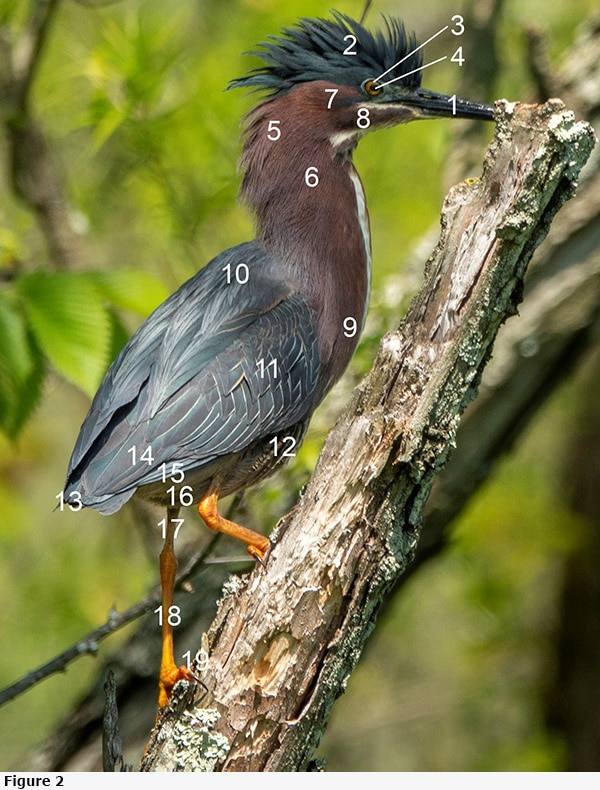
Fig. 2. Simplified external anatomy of a typical bird (non-passerine green heron): 1 Beak, 2 Crown feathers, 3 Iris, 4 Pupil, 5 Nape, 6 Neck and Throat, 7 Auricular, 8 Malar, 9 Breast, 10 Scapulars, 11 Coverts, 12 Belly, 13 Primaries, 14 Tertials, 15 Secondaries, 16 Vent, 17 Tibia, 18 Tarsus, 19 Toe. (Photo: Scott Young)
Of course, as you zoom into a region of a bird, there is more detail to observe. And this may vary between the passerine order (song birds) and the various non-passerine orders. For example, here is an examination of a white-throated sparrow (a passerine) head and neck:
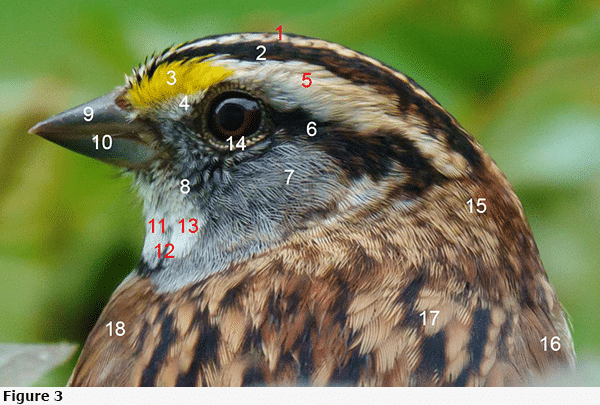
Fig.3. Includes: 1 Median crown strip, 2 Lateral crown stripe, 3 Supraloral area, 4 Lore, 5 Supercillium or eyebrow stripe, 6, Eyeline or eyestripe, 7 Auricular or cheek, 8 Mustache or moustachial stripe, 9 Upper mandible, 10 Lower mandible, 11 Throat, 12 Malar stripe, 13 Submoustachial area, 14 Eye arc or broken eyering, 15 Nape, 16 Mantle, 17 Scapulars, 18 Breast. (Photo: Scott Young)
Bird Anatomy. Test your knowledge and learn more about bird anatomy in this fun interactive page from the Cornell Lab of Ornithology.
Bird Color
Have you wondered how birds can be so colorful, what gives them their coloration? Basically, it comes down to essentially six known processes, although each is quite intricate and there is still a lot to learn about them.
The six processes are: syntheses and depositions of 1) eumelanins, 2) pheomelanin 3) psittacofulvins, and 4) porphyrins; 5) ingestion and processing of pigment precursors (for example, carotenoids and vitamin A); and 6) structural modifications of the feathers.
- Eumelanins lead to brown and black colors. They are formed by complicated enzymatic processes that begin with the amino acid tyrosine. This process, melanogenesis, leads to the polymer pigments being transported in the melanophores of melanocytes to the feathers where the melanophores are taken up. The more oxidation, the darker the eumelanin. Also, eumelanin deposition helps strengthen the feathers and are essential for complex plumage patterns (Galván et al., 2017). The “brown” mutation in which normally black feathers become brown, results from decreased oxidation.
- Pheomelanins lead to yellow to reddish colors and share some of the synthetic pathway used for eumelanin synthesis. Pheomelanins specifically incorporate cysteine derivatives into the pigment polymer.
- Psittacofulvins are especially prominent in parrots (including budgerigars) and lead to their bright-red, orange, and yellow colors. There seems to still be a bit of uncertainty as to the biosynthesis of these pigments, but most evidence supports an endogenous synthesis from fatty acids (Cooke et al., 2017) that is not dependent on ingested carotenoids.
- Porphyrins are synthesized within the bird and deposited in the feathers as a bright red under ultraviolet light. Under visible light, they can display a range of colors from pale pink to stunning greens and reds. Recently, the Great Bustard (Otis tarda) was shown to deposit certain porphyrins as a pink color in feathers of their bellies. The pink color is readily photo-bleachable and may present a transient reproductive signal (Galván et al., 2016). Turacoverdin and turacin are porphyrin-derived pigments responsible or bright green and red colors, respectively, of turacos (family Musophagidae) in Africa. Turacoverdin is the only known green pigment in birds. Green in other birds is produced though a combination of yellow pigments (from carotenoids or psittacofulvins, for example) and the blue color from structural feather features (see below).
- Ingestion of carotenoids leads to deposition of yellow, orange and red pigments. Carotenoids are produced by many organisms, including plants and crustaceans. The carotenoids may or may not be modified. There is evidence to suggest that intensity of pigmentation is correlated with fitness (Weaver et al., 2018). A great example of carotenoid coloration is the American Flamingo (Phoenicopterus ruber), a bird that would be much paler without its diet of crustaceans and plant plankton.
About 10% of starling species have bright coloration due to carotenoid ingestion. Interestingly, the strong yellow plumage of the Golden-breasted Starling (Cosmopsarus regius) does not use carotenoids directly for this color. Instead, for the yellow this African bird deposits vitamin A, a smaller retinoid derived from carotenoid, (Galván et al., 2019), a unique situation at this point.
- Finally, fine structural modifications of feathers can lead to blue and green colors as well as iridescence (as seen in Eurasian Starlings (Sturnus vulgaris)). Although some of the general principles (for example, wave interference) have been understood to some degree for over 300 years, much progress has been made recently regarding the microscopic structural requirements. These include thin-film microstructures and nanochannel matrices that reflect particular wavelengths of light. Lawe’s parotia (Parotia lawesii) bird-of-paradise uses structural elements to produce both green and blue colors for example.
Recently, a different form of structural color approach was found in paleognaths such as the Southern Cassowary (Casuarius casuarius). This coloration, dubbed “structural gloss,” depends on their narrow feathers having more exposed rachis (central shafts). This allows greater directional reflectance (specular reflectance), as from a mirror (Eliason & Clarke, 2020). The interested reader is referred to further literature (van Grouw, 2019; Price-Waldman & Stoddard, 2021).
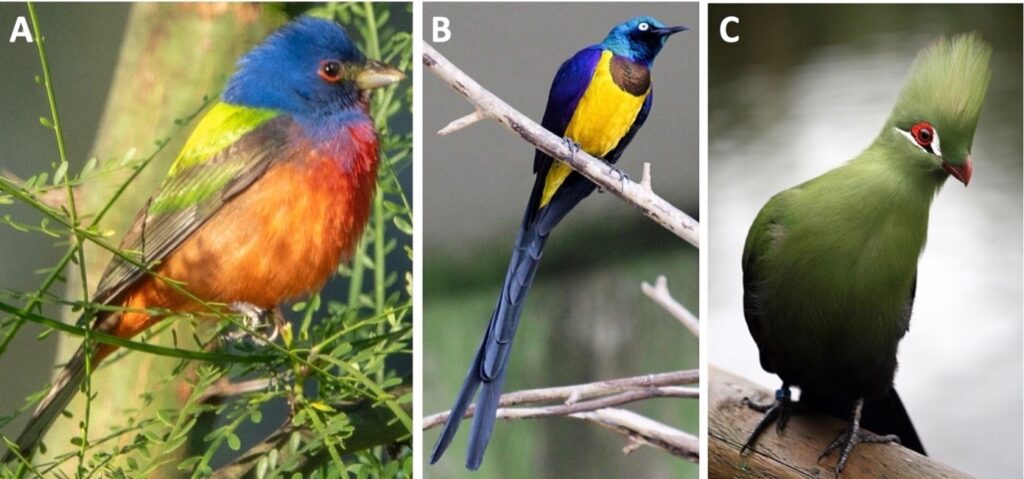
Figure. The fantastic colors of birds. The brown colors of the Painted Bunting (Passerina ciris) (A) and bib of the Golden-breasted Starling (Cosmopsarus regius) (B) are produced from eumelanins. The yellow, red and orange of the Pained Bunting are due to carotenoid depositions. The blues of the bunting and starling (and its iridescence) are produced through structural features of the feathers. The green of the bunting is the combined result of yellow carotenoid and blue structural feathers whereas the green feathers of the Guinea Turaco (Tauraco persa)(C) is due to turacoverdin deposition. Is the red eye-ring produced by turacin or carotenoid deposition? (Photo credits: Scott Young, Wikipedia, Wikipedia)
______________________________________________________
Mutations in color formation add to the variety in bird coloration as well. Albinism, due to the genetic loss of tyrosinase necessary for formation of the melanins, results in white feathers and pink eyes and legs. Feathers that are colored by non-melanins (for example, carotenoids) are unaffected. This is actually an uncommon mutation in birds, in part because they become less fit due to weaker feathers. As this is an inherited defect in all cells, there is no such thing as partial albinism in birds.
Another mutation that leads to white feathers is leucism, due to the failure of melanocytes carrying the pigments to the feathers and skin to either develop or migrate. Again, non-melanin-colored feathers are unaffected. This discoloration is generally symmetrical, present at and unchanged from birth, and may be complete or partial. Progressive graying is a much more common cause of white feathers and often mischaracterized as partial leucism. This defect is characterized by progression with aging and asymmetric appearance of white feathers. There are a number of less common mutations and the interested reader is directed to the review by van Gouw (2018).
Finally, color can be added cosmetically by a bird’s secretions or other actions (Delhey et al., 2007). The yellow bill colors of many hornbills are produced by secretions from the uropygial gland, for example. Amazingly, already pink American Flamingos add further red color by smearing oil from its uropygial gland as well (Amat et al., 2011)! Other birds, such as some vulture species add color from the soil or mineral rich water. (Negro et al., 1999; van Overveld et al., 2017).
References
Amat, J. A., Rendón, M. A., Garrido-Fernández, J., Garrido, A., Rendón-Martos, M., & Pérez-Gálvez, A. (2011). Greater flamingos Phoenicopterus roseus use uropygial secretions as make-up. Behavioral Ecology and Sociobiology, 65(4), 665-673. https://doi.org/10.1007/s00265-010-1068-z
Cooke, T. F., Fischer, C. R., Wu, P., Jiang, T. X., Xie, K. T., Kuo, J., Doctorov, E., Zehnder, A., Khosla, C., Chuong, C. M., & Bustamante, C. D. (2017). Genetic Mapping and Biochemical Basis of Yellow Feather Pigmentation in Budgerigars. Cell, 171(2), 427-439.e21. https://doi.org/10.1016/j.cell.2017.08.016
Delhey, K., Peters, A., & Kempenaers, B. (2007). Cosmetic coloration in birds: occurrence, function, and evolution. Am Nat, 169 Suppl 1, S145-58. https://doi.org/10.1086/510095
Eliason, C. M., & Clarke, J. A. (2020). Cassowary gloss and a novel form of structural color in birds. Sci Adv, 6(20), eaba0187. https://doi.org/10.1126/sciadv.aba0187
Galván, I., Camarero, P. R., Mateo, R., & Negro, J. J. (2016). Porphyrins produce uniquely ephemeral animal colouration: a possible signal of virginity. Sci Rep, 6, 39210. https://doi.org/10.1038/srep39210
Galván, I., García-Campa, J., & Negro, J. J. (2017). Complex Plumage Patterns Can Be Produced Only with the Contribution of Melanins. Physiol Biochem Zool, 90(5), 600-604. https://doi.org/10.1086/693962
Galván, I., Murtada, K., Jorge, A., Ríos, Á., & Zougagh, M. (2019). Unique evolution of vitamin A as an external pigment in tropical starlings. J Exp Biol, 222(Pt 11), jeb205229. https://doi.org/10.1242/jeb.205229
Negro, Margalida, Hiraldo, & Heredia. (1999). The function of the cosmetic coloration of bearded vultures: when art imitates life. Anim Behav, 58(5), F14-F17. https://doi.org/10.1006/anbe.1999.1251
Price-Waldman, R., & Stoddard, M. C. (2021). Avian Coloration Genetics: Recent Advances and Emerging Questions. J Hered, esab015. https://doi.org/10.1093/jhered/esab015
van Grouw, H. (2018). White feathers in black birds. British Birds, 111, 250-263.
van Grouw, H. (2019). Plumage, Structure, and Colour. BTO NEWS, 19, 16-19.
van Overveld, T., de la Riva, M., & Donázar, J. A. (2017). Cosmetic coloration in Egyptian vultures: Mud bathing as a tool for social communication. Ecology, 98(8), 2216-2218. https://doi.org/10.1002/ecy.1840
Weaver, R. J., Santos, E. S. A., Tucker, A. M., Wilson, A. E., & Hill, G. E. (2018). Carotenoid metabolism strengthens the link between feather coloration and individual quality. Nat Commun, 9(1), 73. https://doi.org/10.1038/s41467-017-02649-z
Reproduction
Female birds have a pair of dissimilar ZW chromosomes, and males have two similar ZZ chromosomes. Unlike mammals, males are the homogametic sex (ZZ), while females are the heterogametic sex (ZW). Males have a pair of testes but most adult females generally have only a left ovary, the fetal right one having atrophied. Kiwis, for example, have two functional ovaries as adults. Most male birds have no phallus, although the early ancestors did. However, waterfowl and some other birds, such as the ostrich and turkey, still do. Ninety-five per cent of bird species are socially monogamous.
Respiration
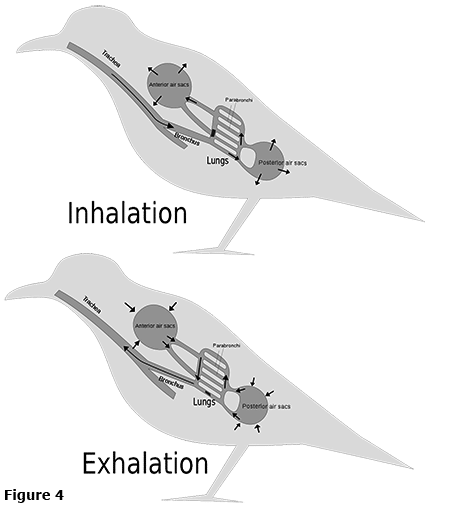 Respiration: An intriguing aspect of bird physiology is the delivery of oxygen to their tissues through respiration. Flying demands large and efficient delivery of this element to satisfy the high metabolic needs. Birds do not have elastic, expandable lungs. Instead, they have evolved a system by which the air is continuously flowing through parabronchi where oxygen is absorbed and carbon dioxide is removed during both inhalation and exhalation. During inhalation, air enters through the nostrils, trachea, syrinx and primary pulmonary bronchi. The fresh air then enters the intrapulmonary bronchi and passes through the much smaller dorsobronchi (for gas exchange) as well as into the expanding posterior air sacs for temporary storage. Spent air, having passed through the dorsobronchi, exit through the ventrobronchi and is stored in the expanding anterior air sacs. Upon exhalation, the compressing posterior air sacs push more air through the dorsobronchi for air exchange. Spent air in the ventrobronchi and compressing anterior air sacs is then expelled through the intrapulmonary bronchi and trachea to the outside. (Figs. 4 and 5)
Respiration: An intriguing aspect of bird physiology is the delivery of oxygen to their tissues through respiration. Flying demands large and efficient delivery of this element to satisfy the high metabolic needs. Birds do not have elastic, expandable lungs. Instead, they have evolved a system by which the air is continuously flowing through parabronchi where oxygen is absorbed and carbon dioxide is removed during both inhalation and exhalation. During inhalation, air enters through the nostrils, trachea, syrinx and primary pulmonary bronchi. The fresh air then enters the intrapulmonary bronchi and passes through the much smaller dorsobronchi (for gas exchange) as well as into the expanding posterior air sacs for temporary storage. Spent air, having passed through the dorsobronchi, exit through the ventrobronchi and is stored in the expanding anterior air sacs. Upon exhalation, the compressing posterior air sacs push more air through the dorsobronchi for air exchange. Spent air in the ventrobronchi and compressing anterior air sacs is then expelled through the intrapulmonary bronchi and trachea to the outside. (Figs. 4 and 5)
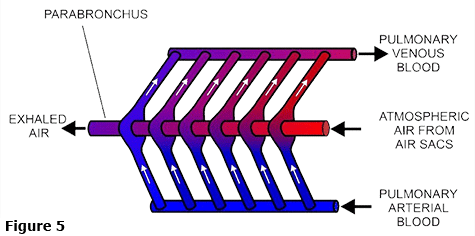 Fig. 5. Airflow and capillary gas exchanger schematic. The oxygen-poor/carbon dioxide rich blood of the pulmonary arterial system exchanges with the air from the posterior air sacs to collect oxygen and dispose of carbon dioxide that goes into the air destined for the anterior air sacs (Fig. 5). (Illustration: Wikipedia)
Fig. 5. Airflow and capillary gas exchanger schematic. The oxygen-poor/carbon dioxide rich blood of the pulmonary arterial system exchanges with the air from the posterior air sacs to collect oxygen and dispose of carbon dioxide that goes into the air destined for the anterior air sacs (Fig. 5). (Illustration: Wikipedia)
Your Content Goes Here
Definitions
Sources: New Oxford American Dictionary; Wikipedia
Ornithology: the scientific study of birds. From the late 17th century from modern Latin ornithologia, from Greek ornithologos ‘treating of birds’.
Birds: are a group of warm-blooded vertebrates constituting the class Aves, characterized by feathers, toothless beaked jaws, the laying of hard-shelled eggs, a high metabolic rate, a four-chambered heart, and a strong yet lightweight skeleton.
Paleontology: the branch of science concerned with fossil animals and plants. From mid 19th century: from paleo- + Greek onta ‘beings’ (neuter plural of ōn, present participle of einai ‘be’) + -logy.
Phylogeny: the branch of biology that studies the evolutionary development and diversification of a species or group of organisms, or of a particular feature of an organism. From the late 19th century from Greek phulon, phulē ‘race, tribe’+ -geny – ‘birth’.
Taxonomy: the identification, naming and classification of organisms. From the early 19th century: coined in French from Greek taxis ‘arrangement’ + -nomia ‘distribution’.
Ontogeny: the branch of biology that studies the development of an individual organism or anatomical or behavioral feature from the earliest stage to maturity. From the late 19th century from Greek ōn, ont- ‘being’+ -geny – ‘birth’.
Anatomy: the branch of science concerned with the bodily structure of humans, animals, and other living organisms. From the late Middle English: from Old French anatomie or late Latin anatomia, from Greek, from ana- ‘up’ + tomia ‘cutting’ (from temnein ‘to cut’).
Physiology: the branch of biology that deals with the normal functions of living organisms and their parts. From the early 17th century: from Latin physiologia (perhaps via French), from Greek phusiologia ‘natural philosophy’.
Passerine: is any bird of the order Passeriformes (Latin passer (“sparrow”) + formis (“-shaped”)), which includes more than half of all bird species. Sometimes known as perching birds or songbirds, passerines are distinguished from other orders of birds by the arrangement of their toes (three pointing forward and one back), which facilitates perching.


